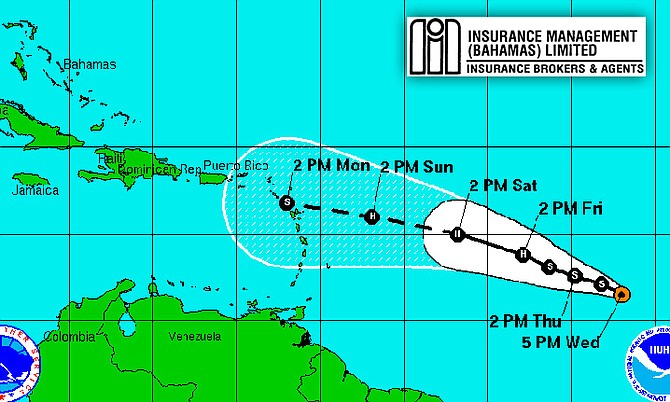TROPICAL Storm Danny - the fourth named storm of the season - is strengthening far out in the Atlantic Ocean and could become a hurricane on Thursday, the National Hurricane Centre (NHC) in Miami said on Wednesday morning.
The storm, which has the potential to become the first hurricane of the Atlantic season, currently poses no threat to land and there are no watches or warnings in effect.
The NHC said that Danny was located about 1,445 miles east of the Windward Islands just north of the equator with maximum sustained winds of 50mph and moving west at 14mph.
AccuWeather Meteorologist Jordan Root said on Tuesday night: “Showers and thunderstorms continue to spiral around an area of circulation and organisation seems to be increasing as this feature moves through favourable conditions during the middle days of this week.”
The exact track of the system beyond several days is described as “questionable”. A track across the Windward or Leeward islands on Monday then into the Caribbean later next week is most likely, provided the system remains relatively weak. However, a curve to the northwest and dissipation are also possibilities.
Should the system ramp up quickly to a hurricane, then a move to the northwest would be more likely. Another significant area of disturbed weather is forecast to soon emerge off the African coast later this week.
Last week, The Tribune was told by international weather experts that if newly updated weather projections hold true, this year’s Atlantic hurricane season would be the least active since 1997.
AccuWeather’s senior meteorologist and lead hurricane forecaster Dan Kottlowski said that storm developments remain few and far between due to the strength of this year’s El Nino forecast and the surface water temperatures across the Atlantic.
The United States’ Climate Prediction Centre recently adjusted its Atlantic hurricane season outlook to a 90 per cent chance of a below-normal hurricane season, 20 per cent higher than projections given in May.
Mr Kottlowski indicated that on average, the strength of El Nino determines the wind shear over the tropical Atlantic basin. “The stronger the system, the stronger the shear, the less of a chance for a storm to develop. A strong vertical wind shear and an enhanced sinking motion across the tropical Atlantic and Caribbean Sea, are now present,” he said. “These conditions make it difficult for storms to develop.”
Mr Kottlowski noted that the second factor contributing to the weak season to date is the below average surface water temperatures. A tropical system typically needs water temperature of 82 degrees or above to develop and strengthen.
However, Mr Kottlowski said experts have seen below average temperatures across the Atlantic region, another trend he predicted will carry throughout the rest of this season.
The National Oceanic and Atmospheric Administration had projected a slow season and revised its predictions for this year’s storm season – which runs from June 1 to November 30 – to six to 10 named storms, one to four of which could reach hurricane intensity.
Mr Kottlowski added that while the changes in projections might signal a weaker than expected season, he warned that there are still three months remaining in this year’s season. “Projections show that this would be a slow year but that doesn’t mean it should be overlooked,” he added.
To date this summer, there have been three named storms – Ana, Bill, and Claudette. Ana made landfall in South Carolina in the US in May, and Bill made landfall in Texas in June.





Comments
John 8 years, 8 months ago
The ocean is very warm so this could be a strong one
Sign in to comment
Or login with:
OpenID